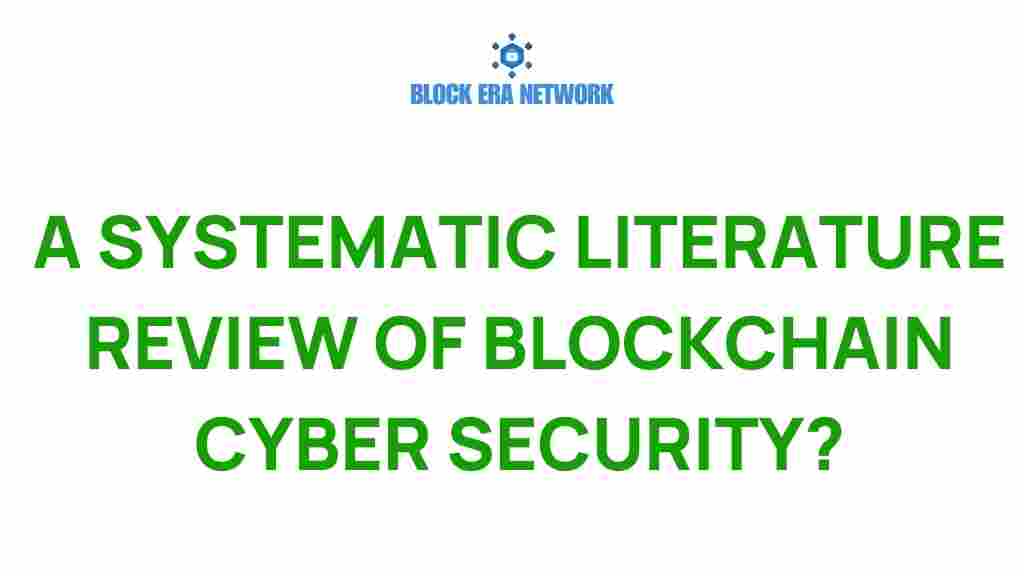Unveiling Blockchain Cyber Security: A Systematic Literature Review
In recent years, the intersection of blockchain technology and cyber security has garnered significant attention. As decentralized networks gain traction, understanding the vulnerabilities and security measures associated with them is crucial. This article presents a systematic review of the literature surrounding blockchain cyber security, focusing on vulnerabilities, encryption, data protection, threat analysis, and security measures.
Introduction
Blockchain technology, originally designed for cryptocurrency, has evolved into a robust framework for various applications, including supply chain management, healthcare, and finance. However, as with any technological advancement, the rise of blockchain has also introduced new challenges in the realm of cybersecurity. The decentralized nature of blockchain provides inherent security benefits, but it is not impervious to threats. This article aims to dissect these vulnerabilities through a systematic review of existing literature.
Understanding Blockchain Technology
Before delving into the vulnerabilities and security measures, it’s essential to grasp the fundamentals of blockchain technology:
- Decentralization: Unlike traditional databases, blockchain operates on a distributed network, where data is stored across multiple nodes.
- Immutability: Once data is recorded on a blockchain, it cannot be altered without consensus from the network.
- Transparency: Transactions on a blockchain are visible to all participants, enhancing trust.
- Encryption: Data is secured through advanced cryptographic techniques, ensuring confidentiality and integrity.
Vulnerabilities in Blockchain Systems
Despite its advantages, blockchain technology is not without vulnerabilities. A systematic review of the literature reveals several critical areas of concern:
- 51% Attack: If a single entity controls more than half of the network’s computational power, it can manipulate transactions.
- Smart Contract Vulnerabilities: Bugs in smart contracts can lead to significant financial losses and exploits.
- Phishing Attacks: Users can fall victim to phishing schemes, compromising their private keys and funds.
- Sybil Attacks: Malicious actors can create multiple identities to gain influence over the network.
- Insufficient Security Measures: Poorly implemented security protocols can expose networks to risks.
Encryption and Data Protection in Blockchain
Encryption plays a pivotal role in ensuring data protection within blockchain systems. Here are some key encryption techniques utilized:
- Public Key Cryptography: Each user has a pair of keys (public and private) for secure transactions.
- Hash Functions: Transactions are hashed to create a unique digital fingerprint, enhancing integrity.
- Zero-Knowledge Proofs: This allows one party to prove they know a value without revealing the value itself.
These encryption mechanisms help mitigate vulnerabilities and enhance the overall security of decentralized networks.
Threat Analysis in Blockchain Cyber Security
A comprehensive threat analysis is essential for identifying potential risks associated with blockchain implementations. The systematic review highlights various threat vectors:
- Network Attacks: Threats such as Distributed Denial of Service (DDoS) attacks can disrupt network operations.
- Malware: Malware targeting wallets and exchanges can lead to unauthorized access and theft.
- Insider Threats: Employees with access to sensitive information may intentionally or accidentally compromise security.
Organizations should conduct regular threat assessments to stay ahead of potential risks.
Implementing Effective Security Measures
To safeguard blockchain networks, a variety of security measures can be adopted:
- Regular Audits: Conducting security audits can help identify vulnerabilities and rectify them promptly.
- Multi-Signature Wallets: Requiring multiple approvals for transactions enhances security.
- Education and Awareness: Training users about phishing and other attack vectors can reduce human error.
- Adopting Best Practices: Following established best practices in coding and deployment can mitigate risks.
Step-by-Step Process for Securing Blockchain Systems
Implementing robust security measures on a blockchain system involves a systematic approach:
- Identify Assets: Determine valuable assets that require protection.
- Conduct Risk Assessment: Analyze potential threats and their impact on the assets.
- Implement Security Controls: Choose appropriate security measures based on the risk assessment.
- Monitor the Network: Continuously monitor for unusual activity or breaches.
- Review and Update Security Policies: Regularly update security policies to adapt to emerging threats.
Troubleshooting Common Blockchain Security Issues
Even with the best security measures in place, issues may arise. Here are troubleshooting tips for common blockchain security problems:
- Transaction Failures: Check for network congestion and ensure adequate gas fees are set.
- Smart Contract Bugs: Review the contract code and test for vulnerabilities before deployment.
- Unauthorized Access: Ensure that private keys are stored securely and use hardware wallets for added protection.
- Data Breaches: Investigate the breach source and enhance security measures to prevent future incidents.
Conclusion
The integration of blockchain technology into various sectors introduces both opportunities and challenges. The systematic literature review conducted highlights significant vulnerabilities and outlines essential security measures for blockchain cyber security. By understanding these vulnerabilities, implementing robust encryption techniques, conducting thorough threat analyses, and adopting effective security measures, organizations can significantly enhance their data protection strategies.
As blockchain technology continues to evolve, staying informed and proactive in addressing cyber security challenges will be crucial. For more detailed insights into blockchain security, you can refer to this external resource. Additionally, for further reading on cyber security practices, check out our internal guide.
In conclusion, while blockchain offers a promising future for secure transactions, it is imperative to recognize and address its vulnerabilities through ongoing research and proactive security strategies.
This article is in the category Crypto Security and created by Block Era Network Team
